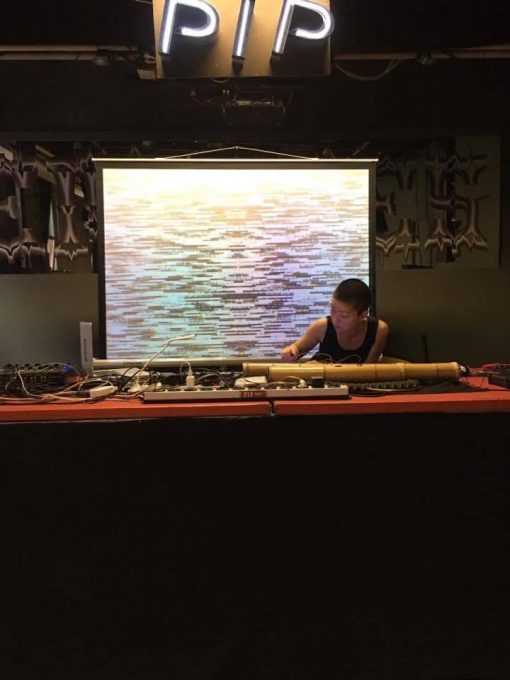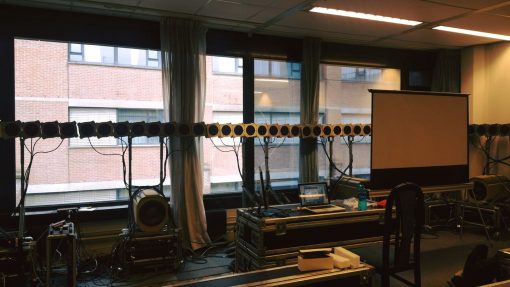How was your year? It’s always exciting to look forward to a new year, making and setting up a fresh plan with a full of motivation! At the same time, it is very important to think about the past year, what are the achievements, and what I have missed.
This post is about my memorable activities of the year 2017. I selected 4 activities:
-
DELETION at International Film Festival Rotterdam
‘DELETION’ is a short film made by Esther Urlus, who I met two years ago for Light Leak project with Filmwektplaats. She’s a special filmmaker in The Netherlands, who create DIY 16mm experimental films. The length of the film is around 10 minutes, completely abstract, accordingly there was enough space for me to explore with sounds. The film is about a murder scene -accordingly, a horror movie!- but you don’t see or recognize anything through the screen. The story is behind the complete abstract scenes. The soundtrack therefore has a big role for audience to follow the story line.
Thankfully this film was nominated at Tiger Competition for Short Films 2017 at IFFR, which gave me a totally new experience to attend the festival, sitting there with other amazing filmmakers and actors/actresses. Even though the film wasn’t the winner, it was for me a great achievement. I hope to have more opportunities working on films. I quite like it.
-
Azimuth #3
 ‘Azimuth’ is a foundation that their multichannel system offers composers/artists to create spatial music/arts with the system. Azimuth #3 was my first experience with it. The piece I wrote is ‘Punky-Pulse-Pool’ for 32 channels.
‘Azimuth’ is a foundation that their multichannel system offers composers/artists to create spatial music/arts with the system. Azimuth #3 was my first experience with it. The piece I wrote is ‘Punky-Pulse-Pool’ for 32 channels.
The materials were created from a short theme, a gesture using pulse oscillator, and as in variations on a theme, it was developed, manipulated, and re-synthesized into diverse forms. Then instead of presenting them one after another, they were massively and randomly thrown in time and in space. As if one freely plays a puzzle with multiple different blocks, the layered and squeezed sound materials are then sculpted and re-organized not only musically but also spatially. In that way new relationships between sound events are revealed, and the allied, survived sound parts are newly developed from there with a found connectivity.
I wrote the blog post about my experience in more detail. -
‘Bamboos’ for Bamboos

Some might remember those Bamboo instruments that I made a piece for some years ago. Then I wanted to do something different with it, and here I made a live piece using them. Here I use(make) them as resonating ‘electronic flutes’ using audio feedback system. When I close the holes, their original tone varies. The feedback works like ‘breathes.’ Then I apply a number of signal processing. Together with it, I attached small metal rings on the holes that are wired to Arduino that gives a low voltage flow. My touch could change its voltage as I am also connected to another analog circuit. In other words, the voltage flows throughout my body and whenever the contact is made between me and the instruments, it changed. The variation is chaotic, unpredictable. Then this signal is added to the feedback sound, which is related also to the movement of my fingers. The program note for the piece is below.Notes on “Bamboos”: Bamboos, their bodies, their own resonating voices. Every other gesture drives from there, as the performer continuously tries to distort, differentiate, and control them until the instruments and performer become strongly linked together. The whole space, occupied by bamboos’ stubborn voices whose struggles are running and jumping all over, later on becomes part of the resonating body, singing and breathing all together.
-
Staff at the Institute of Sonology

Probably the most surprising news was that I became a staff member in Sonology, where I studied and achieved Master Degree, for which I came here in The Netherlands. Somehow, probably it was my dream, one day, teaching here. Luckily and thankfully I got this opportunity.
The subject I am teaching is ‘Spatial Music Composition for WFS system.’ The course is designed for students to plan and proceed their project with the WFS system and I give lectures on Spatial music with tons of musical examples of other composers, history on spatial music and spatialization system/tools, the meaning of space, musical space, and practical knowledge on how to use the WFS system. It demands quite some research that I enjoy very much. It is definitely a new experience for me, and there is far more to become better.
Well, that’s it. Now it’s the beginning of the new year 2018. I am very much looking forward to seeing what will come to my life. Hopefully it becomes a very creative, more musical, and inspiring year. It’s mostly up to me.
I wish all of the readers a very happy new year!

